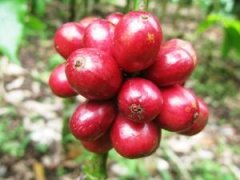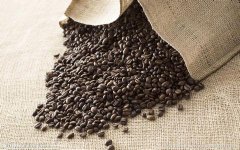The production of Italian espresso Espresso
Making a good Espresso can be a challenge for both coffee lovers at home and the experienced Barista in the cafe. Below, we will discuss the various factors that affect Espresso.

1. Coffee beans
There is no good Espresso without good coffee beans. Coffee beans must be fresh. As far as Espresso is concerned, the consistency, thickness and color of the coffee extracted from stale coffee beans will be seriously affected, and the taste will be greatly reduced.
2. Baking
Roast the raw coffee beans to make the coffee beans show a unique color, aroma and taste. The taste of coffee depends 80% on roasting. (for details, see: coffee bean baking methods and principles)
3. Coffee powder
The coffee powder must be thick enough to keep the extraction process between 25 and 30 seconds. Once the coffee beans are ground, the flavor can be preserved for no more than an hour. In order to keep the coffee fresh, the coffee powder should be ground fresh.
4. Bean grinder
Cone-shaped grinding plates are more average and have a longer life than flat ones, and coffee beans are not heated during grinding. If the temperature is too high during grinding, the coffee will lose its flavor. At present, the cone type and peace type combined grinding plate is the best design. The bean grinder should be often cleaned and kept clean, and the grinding plate should be updated in time, so that the bean can be in full contact with the surface of the grinding plate.
5. Coffee quantity
It usually takes 7 grams of coffee powder and 40 to 65 milliliters of water to boil a small cup of Espresso. If you want stronger coffee, you can reduce the amount of water. The correct amount of extraction should be between 1 and 1.25 ounces (flushing out 1 ounce in 25 seconds is the best performance).
6. Powder loading and pressing
Coffee powder needs to be flat and smooth, and coffee powder must be evenly distributed in the filter. Usually you can use 5 pounds of pressure powder once, then 30 pounds of pressure once, and then rotate 720 °with 20 pounds of pressure to make the powder surface smooth and smooth.
7. Water
The water used for Espresso must be purified. Some cities need to use trace elements to balance water quality. The water will go bad if it is in the coffee machine for too long. Use a small glass to connect a cup of water in the coffee machine, cool and try, such as the water has gone sour, replace the water in the machine with fresh water.
8. Water temperature
The water temperature must be stable at 90 °±5 °. When choosing Espresso machine, we must pay attention to the stability of water temperature and water temperature. If the water temperature is too low, it will cause insufficient extraction, and the substances inside the coffee can not be fully released, so that you can only cook a cup of Espresso; with insufficient flavor and sour taste. Once the water temperature is too high, excessive extraction will make the coffee bitter and astringent.
9. Water pressure
The pressure of water is 9 ±2 atmospheric pressure (bar). The general hot water brewing method can only extract the water-soluble substances inside the coffee, and Espresso can further extract the water-insoluble substances by high pressure. These high pressures will completely emulsify the lipids inside the coffee and dissolve it into water, which is the main source of "body". Emulsification will make Espresso taste thicker, making people drink with a "velvety" feeling; and stickiness will form a lower surface tension, more able to invade the taste buds, so that mellow reverberate in the mouth for a long time. The most important sign of a good Espresso is that it has a light camel-colored emulsion (Crema), which is a mixture of fat, water and air in the coffee during the extraction process. The emulsion should be uniform in color, about 3 cm to 5 cm thick, shake the coffee cup gently, and this layer of emulsion will stick to the wall like thick syrup. If the emulsion is dark brown or even black, the coffee is overextracted; if it is yellowish, the coffee has not been fully extracted.
10. Extraction time
The extraction time was 30 ±5 seconds. It is generally believed that when extracting Espresso, the quality of two cups extracted at the same time is more perfect than that of one cup alone. The extraction time for making two 1-ounce cup Espresso should be between 25 and 30 seconds. In addition to time, if the color of the Espresso begins to fade, the production process should be completed. The goal should be to produce a dark red Espresso within 25-30 seconds without changing color.
11. Filter handle and filter
The filter handle must be kept at the same temperature as the water temperature used to make the Espresso. Therefore, the handle should be preheated on the head of the machine.
12. Machine cleaning
If the machine, filter and filter handle are not cleaned, the Espresso will smell of rotten oil.
13. Environmental factors
The humidity and temperature of the air will change during the day. Because coffee powder is easy to absorb moisture, the thickness of the bean grinder also needs to be adjusted so that the thickness of the powder can reach 25-30 seconds during extraction.
18. Espresso Cup
In order to maintain the heat and aroma, the Espresso cup has a thick wall and a narrow mouth. Espresso cup should be preheated.
The change of any of these factors will increase or decrease the perfection of Espresso. The production of Espresso is a kind of art, and the perfect Espresso may be just a concept and cannot be realized. The beauty of Espresso lies in its fickleness and difficulty. Because there are so many influencing factors, only the human brain and the emotional heart can understand and control the complexity of Espresso.
Important Notice :
前街咖啡 FrontStreet Coffee has moved to new addredd:
FrontStreet Coffee Address: 315,Donghua East Road,GuangZhou
Tel:020 38364473
- Prev

Coffee beans, coffee beans, coffee beans
Coffee should be kept as beans as possible and ground before extraction. The main points of grinding are as follows: 1. The grinding degree should be even. Uneven grinding will cause uneven extraction, so that the extracted coffee liquid taste messy. 2 Minimize frictional heat generated when grinding beans. The frictional heat generated during grinding can significantly damage the taste and aroma of coffee. heat generation during grinding is inevitable,
- Next

Boutique coffee beans roast coffee beans by yourself
Some coffee lovers like to buy raw coffee beans and bake them by themselves. Self-baking is not only easy, but also effective, so anyone who is interested can try it. Not only can you bake as much as you need, but the most interesting thing is that each time you bake, you are facing the coffee beans, and observe the coffee beans in the roaster closely through the smell, color, dandruff, smoke and sonic explosion.
Related
- What is the meaning of lactic acid fermentation with coffee bean treatment?
- How to judge the state of foam by sound?
- How does the latte pull out the unicorn pattern? Come to get for a little trick to improve the flower pull!
- Will flower pulling affect the taste of the latte?
- Do you know the history of coffee?
- The difference between honey treatment and sun washing what is raisin honey treatment?
- What kind of milk can a novice use to make coffee foam to keep the foam longer? The correct method and skills of milking tutorial sharing
- Why do washed coffee beans taste sour? Flavor characteristics of washed Coffee
- Introduction to the skill of how to practice the size and height of water injection around the circle of hand-brewed coffee
- How do beginners practice coffee flower drawing from scratch?

